Free signup for more
- Track your favorite companies
- Receive email alerts for new filings
- Personalized dashboard of news and more
- Access all data and search results
Content analysis
?| Positive | ||
| Negative | ||
| Uncertain | ||
| Constraining | ||
| Legalese | ||
| Litigous | ||
| Readability |
H.S. sophomore Avg
|
|
New words:
abandoned, accrual, affinity, albeit, alive, alongside, Atlanta, Baton, Belize, BlueFire, Bottle, box, captioned, certified, chef, children, CIIO, circuit, County, COVID, CulturaTM, debarment, deliberate, detriment, diminished, dispute, disregard, downturn, drop, Efficacy, Elite, emotional, enriched, entrusted, equitable, ESG, Evacuated, eWorq, exploring, extraterritorial, fashion, fewer, fiduciary, fine, foundation, freight, Gallup, garden, gas, geography, globe, greenhouse, hard, harder, healthy, HR, Infiltration, installation, intensify, intermediate, ix, leave, lifestyle, lineup, lingering, logistical, lubricity, mandate, Maute, meal, mediation, mental, military, mission, network, notable, nutritionist, official, officially, OMX, OneVac, onsite, optimum, overcoming, Pacific, parental, Parish, partner, partnered, peaked, penalized, Pension, persist, PIPL, Police, pool, pre, professional, remote, resource, retirement, reveal, RMB, Rouge, satisfaction, sentiment, sick, Siege, SKU, Smart, SplashWire, Steffen, suicide, surveying, thought, threshold, tobacco, TR, treble, Ukraine, unified, unjustly, unpredictable, unspecified, unsteady, upward, vaccination, vaccine, viewed, walking, wellbeing, withheld, WLI, wrongdoing
Removed:
adapt, added, adherence, affix, American, Automatic, Bakelite, beneficiary, Brachy, Cagent, cancelled, Coherence, compostable, cutlery, dialogue, distributor, enrollment, financed, FirstChoice, fistulae, footprint, IC, impracticable, inefficient, investigator, licensed, Melbourne, NAFTA, North, OC, OCT, optical, orthopaedic, Pennsylvania, perception, pipeline, plant, positively, practice, preauthorization, Programmable, quadrasphere, Quellent, radiation, reclassification, recoverability, refusal, renegotiated, repeal, responding, retrospective, reusable, revised, revoke, rotating, scalability, secret, shaped, standalone, starch, sugarcane, sum, Sumitomo, supplementary, taxing, TCJA, thereon, thrombosed, title, Transluminal, ultra, unaudited, underwriting, Venlo, viability, VIE, vigilance, withdrawal
Filing tables
Filing exhibits
Related press release
Associated MMSI transcripts
MMSI similar filings
Filing view
External links

